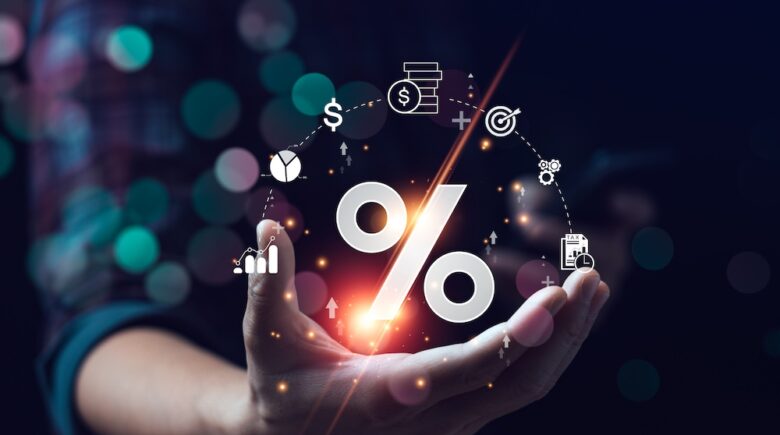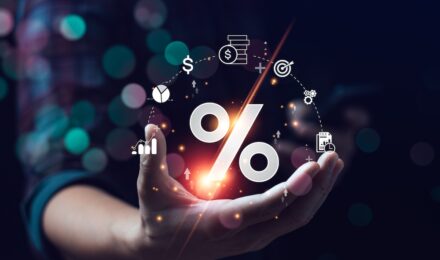Interest rates have been climbing steadily since 2022, and by 2025 borrowers are feeling the weight of higher borrowing costs in nearly every sector. For decades, online lending thrived on convenience and competitive rates. But the current climate has changed the game. Traditional banks, fintech startups, and peer-to-peer platforms are recalibrating strategies to stay competitive while ensuring profitability.
This shift is not just about numbers on a chart. It’s reshaping how lenders assess risk, the kinds of loans they offer, and how borrowers approach financing decisions. For individuals and small businesses alike, the ripple effects are undeniable.
Higher Costs for Borrowers
The most visible impact of rising interest rates is, of course, the cost of borrowing. A personal loan that carried a rate of 6% just a few years ago might now sit closer to 11% or higher. This increase makes monthly payments heavier and total loan costs significantly more expensive over time.
For borrowers, that creates new pressure to shop around for the best deals, carefully compare annual percentage rates (APRs), and reconsider whether certain debts—such as debt consolidation loans or discretionary personal loans—are worth the added cost.
Lenders Adjusting Risk Models
When borrowing is more expensive, fewer people apply. Those who do may be in greater need of funds, which can increase default risk. To counter this, online lenders have begun tightening eligibility criteria. Credit score minimums are creeping upward, income verification requirements are stricter, and some platforms are scaling back loan amounts for higher-risk applicants.
In practice, this means that borrowers with weaker credit histories face steeper barriers to approval. At the same time, those with strong credit are rewarded with more competitive offers, though even they are not immune to higher rates.
Shift in Loan Demand
The types of loans people seek are shifting as well. Debt consolidation remains popular, since rolling multiple high-interest balances into a single fixed-rate loan can still offer savings. However, demand for discretionary borrowing—such as loans for vacations or luxury purchases—has slowed.
On the business side, many small companies are delaying expansion projects or looking for smaller, short-term financing rather than large lump sums. This trend reflects both caution about uncertain economic conditions and an effort to minimize the costs associated with borrowing in a high-rate environment.
Opportunities for Fintech Innovation
Rising interest rates haven’t stifled innovation. In fact, fintech firms are finding ways to stand out. Some platforms are experimenting with AI-driven underwriting that considers more than just credit scores, factoring in banking habits, cash flow, and even alternative data such as utility payments.
Others are introducing flexible repayment options, variable loan structures, or partnerships with employers to provide loans directly through payroll systems. These developments reflect a broader push to keep lending accessible and appealing despite less favorable interest rates.
The Impact on Peer-to-Peer Lending
Peer-to-peer (P2P) lending platforms have seen a mixed effect. On one hand, higher interest rates can attract investors looking for better returns than traditional savings accounts or bonds. On the other, borrowers may hesitate to accept double-digit interest rates on loans from individuals.
As a result, many P2P platforms are refining how they match investors and borrowers, sometimes subsidizing rates to keep offers attractive. Still, this sector remains more sensitive to economic shifts than larger, established lenders.
Small Business Financing in 2025
Small businesses are among the most vulnerable groups in a rising-rate economy. Many rely on loans to manage cash flow, purchase equipment, or expand operations. With financing costs higher, some are leaning toward alternatives such as merchant cash advances or invoice factoring—options that provide liquidity but often come with hidden costs.
Banks and online lenders alike are trying to bridge this gap by offering hybrid solutions, such as shorter-term loans with quicker approval processes. While these products may not solve every problem, they demonstrate how lenders are adapting to small business realities.
Consumer Behavior: Borrowing Less, Saving More
Borrowers are not passive in this environment. Many are rethinking their approach to debt, prioritizing savings, and cutting back on unnecessary borrowing. Surveys in early 2025 suggest that consumers are more cautious, with a growing number choosing to pay down existing debt rather than take on new obligations.
This shift in behavior has long-term implications for lenders. While it may reduce short-term profits, it encourages a healthier credit market with more sustainable borrowing practices.
Regulatory Watch
Governments and regulators are paying close attention to how higher interest rates affect vulnerable borrowers. Discussions are underway in the United States and Europe about capping APRs on certain online loan products, especially those aimed at subprime borrowers.
If implemented, such caps could force lenders to reconsider their business models, potentially reducing access for some but offering greater protection for others. This ongoing debate highlights the tension between financial inclusion and consumer protection in a challenging economic climate.
What This Means for Borrowers in 2025
For individuals and businesses, the takeaway is clear: borrowing is more expensive, but it is not out of reach. Success in this climate depends on preparation and caution. Maintaining a strong credit profile, carefully comparing loan offers, and exploring alternatives such as credit unions or community banks can make a significant difference.
Lenders, meanwhile, are using this period to innovate and prove that online platforms can adapt quickly to new realities. Borrowers willing to explore options and stay informed will be best positioned to find opportunities, even in a high-rate environment.
Final Thoughts
Rising interest rates have introduced new challenges, but they have also underscored the resilience of the online lending market. From fintech innovation to evolving borrower behavior, 2025 is shaping up to be a pivotal year. For borrowers, the key lies in staying informed, comparing offers carefully, and understanding how broader economic forces influence personal financial choices.
References
- Federal Reserve. “Federal Reserve Board – Interest Rate Decisions.” https://www.federalreserve.gov
- Consumer Financial Protection Bureau. “Online Lending: Market Trends and Consumer Impact.” https://www.consumerfinance.gov
- Reuters. “Rising Interest Rates Reshape Lending in 2025.” https://www.reuters.com
Interest rates have been climbing steadily since 2022, and by 2025 borrowers are feeling the weight of higher borrowing costs in nearly every sector. For decades, online lending thrived on convenience and competitive rates. But the current climate has changed the game. Traditional banks, fintech startups, and peer-to-peer platforms are recalibrating strategies to stay competitive while ensuring profitability.
This shift is not just about numbers on a chart. It’s reshaping how lenders assess risk, the kinds of loans they offer, and how borrowers approach financing decisions. For individuals and small businesses alike, the ripple effects are undeniable.
Higher Costs for Borrowers
The most visible impact of rising interest rates is, of course, the cost of borrowing. A personal loan that carried a rate of 6% just a few years ago might now sit closer to 11% or higher. This increase makes monthly payments heavier and total loan costs significantly more expensive over time.
For borrowers, that creates new pressure to shop around for the best deals, carefully compare annual percentage rates (APRs), and reconsider whether certain debts—such as debt consolidation loans or discretionary personal loans—are worth the added cost.
Lenders Adjusting Risk Models
When borrowing is more expensive, fewer people apply. Those who do may be in greater need of funds, which can increase default risk. To counter this, online lenders have begun tightening eligibility criteria. Credit score minimums are creeping upward, income verification requirements are stricter, and some platforms are scaling back loan amounts for higher-risk applicants.
In practice, this means that borrowers with weaker credit histories face steeper barriers to approval. At the same time, those with strong credit are rewarded with more competitive offers, though even they are not immune to higher rates.
Shift in Loan Demand
The types of loans people seek are shifting as well. Debt consolidation remains popular, since rolling multiple high-interest balances into a single fixed-rate loan can still offer savings. However, demand for discretionary borrowing—such as loans for vacations or luxury purchases—has slowed.
On the business side, many small companies are delaying expansion projects or looking for smaller, short-term financing rather than large lump sums. This trend reflects both caution about uncertain economic conditions and an effort to minimize the costs associated with borrowing in a high-rate environment.
Opportunities for Fintech Innovation
Rising interest rates haven’t stifled innovation. In fact, fintech firms are finding ways to stand out. Some platforms are experimenting with AI-driven underwriting that considers more than just credit scores, factoring in banking habits, cash flow, and even alternative data such as utility payments.
Others are introducing flexible repayment options, variable loan structures, or partnerships with employers to provide loans directly through payroll systems. These developments reflect a broader push to keep lending accessible and appealing despite less favorable interest rates.
The Impact on Peer-to-Peer Lending
Peer-to-peer (P2P) lending platforms have seen a mixed effect. On one hand, higher interest rates can attract investors looking for better returns than traditional savings accounts or bonds. On the other, borrowers may hesitate to accept double-digit interest rates on loans from individuals.
As a result, many P2P platforms are refining how they match investors and borrowers, sometimes subsidizing rates to keep offers attractive. Still, this sector remains more sensitive to economic shifts than larger, established lenders.
Small Business Financing in 2025
Small businesses are among the most vulnerable groups in a rising-rate economy. Many rely on loans to manage cash flow, purchase equipment, or expand operations. With financing costs higher, some are leaning toward alternatives such as merchant cash advances or invoice factoring—options that provide liquidity but often come with hidden costs.
Banks and online lenders alike are trying to bridge this gap by offering hybrid solutions, such as shorter-term loans with quicker approval processes. While these products may not solve every problem, they demonstrate how lenders are adapting to small business realities.
Consumer Behavior: Borrowing Less, Saving More
Borrowers are not passive in this environment. Many are rethinking their approach to debt, prioritizing savings, and cutting back on unnecessary borrowing. Surveys in early 2025 suggest that consumers are more cautious, with a growing number choosing to pay down existing debt rather than take on new obligations.
This shift in behavior has long-term implications for lenders. While it may reduce short-term profits, it encourages a healthier credit market with more sustainable borrowing practices.
Regulatory Watch
Governments and regulators are paying close attention to how higher interest rates affect vulnerable borrowers. Discussions are underway in the United States and Europe about capping APRs on certain online loan products, especially those aimed at subprime borrowers.
If implemented, such caps could force lenders to reconsider their business models, potentially reducing access for some but offering greater protection for others. This ongoing debate highlights the tension between financial inclusion and consumer protection in a challenging economic climate.
What This Means for Borrowers in 2025
For individuals and businesses, the takeaway is clear: borrowing is more expensive, but it is not out of reach. Success in this climate depends on preparation and caution. Maintaining a strong credit profile, carefully comparing loan offers, and exploring alternatives such as credit unions or community banks can make a significant difference.
Lenders, meanwhile, are using this period to innovate and prove that online platforms can adapt quickly to new realities. Borrowers willing to explore options and stay informed will be best positioned to find opportunities, even in a high-rate environment.
Final Thoughts
Rising interest rates have introduced new challenges, but they have also underscored the resilience of the online lending market. From fintech innovation to evolving borrower behavior, 2025 is shaping up to be a pivotal year. For borrowers, the key lies in staying informed, comparing offers carefully, and understanding how broader economic forces influence personal financial choices.
References
- Federal Reserve. “Federal Reserve Board – Interest Rate Decisions.” https://www.federalreserve.gov
- Consumer Financial Protection Bureau. “Online Lending: Market Trends and Consumer Impact.” https://www.consumerfinance.gov
- Reuters. “Rising Interest Rates Reshape Lending in 2025.” https://www.reuters.com







